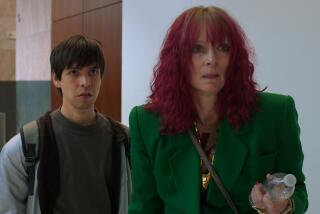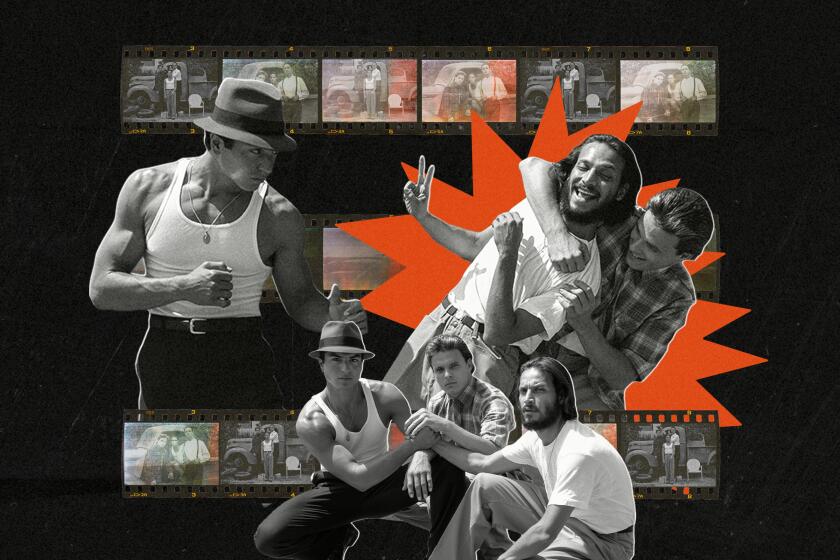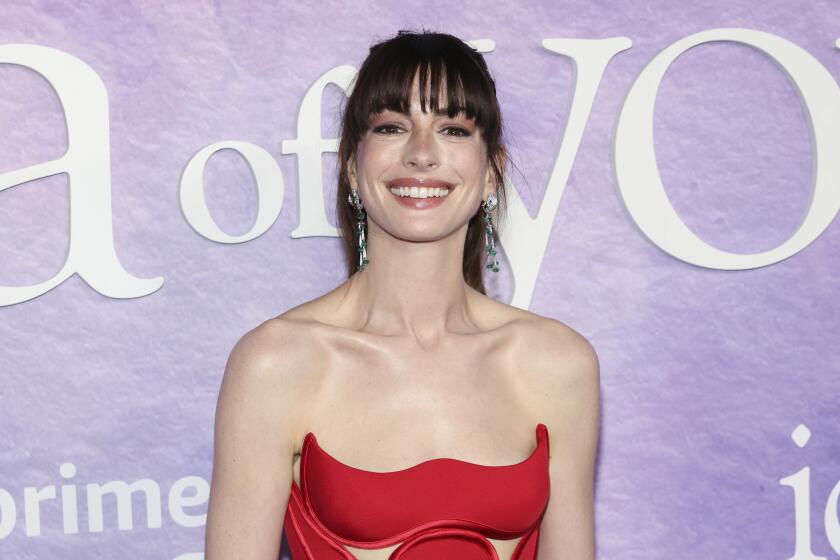In ‘Birdman,’ Alejandro G. Inarritu takes his doubts and lets them fly
NEW YORK — About two years ago, Alejandro G. Iñárritu was contemplating his next film when he found himself at a crossroads.
The Mexican-born director had gone from the upstart status of his early career, with such films as the kinetic “Amores Perros” in 2000 and the awards breakout “Babel” in 2006, to a kind of stasis. His only film since “Babel” — 2010’s terminal-illness drama “Biutiful” — was a lightly seen effort whose unremitting seriousness had led some to ask whether the director was losing his touch.
As it turned out, Iñárritu was posing plenty of questions to himself. A few months shy of 50 and with some of the cinephile buzz of his early career wearing off, he wondered whether he was going about things all wrong. Was he sparking to the right ideas? Was he choosing films based on a fear of failure? And, maybe more troubling, was he at risk of becoming one more foreign-born director with a solid but workaday career in Hollywood, an outcome his perfectionist mind couldn’t abide?
“I went through a deep period, a kind of questioning of my priorities,” Iñárritu said. “And what I saw over this period is that my ego, which can be a cruel dictator, had been playing me.”
Iñárritu realized that these tensions — particularly between what others expected of him and what he wanted from himself — were leading him to unhappily try to repeat past successes. But solutions eluded him. He had made only heavy, mortality-laden dramas — there was a death or fatal disease at the center of each of his four features — and changing keys wasn’t easy.
Then he hit upon a clever, improbable solution: What if he could convert all his doubts into artistry?
Those reflections led to “Birdman,” a playfully meta story of artistic struggle and redemption that operates both inside and outside the frame. “Birdman,” which will close the New York Film Festival on Saturday and opens in theaters Oct. 17, will herald an Iñárritu the film world has never seen — and, equally unlikely, turn a director’s private uncertainty into the stuff of universal identification.
Made over approximately a month in spring 2013 primarily at Broadway’s St. James Theatre (one of the only movies ever to be shot inside a temple of the Great White Way), the darkly funny film follows Riggan Thomson, the former star of the fictional “Birdman” superhero franchise, played by Michael Keaton, a former star of the real-life “Batman” superhero franchise. The actor is haunted by a hectoring inner voice, who plays on his fear that he has become an over-the-hill hack.
To quiet that voice, Riggan has decided to write, direct and star in a serious-minded Broadway adaptation of a Raymond Carver story. But as opening night approaches, the challenges pile up. Riggan does battle with an obnoxious titan of the theater named Mike Shiner who’s starring opposite him (Edward Norton), with his alienated grown daughter and assistant Sam (Emma Stone) and with a creeping sense that all his dedication is about to be rewarded with a critical pummeling. “Birdman” is a backstage comedy centered on an existential crisis, “My Favorite Year” re-imagined by Albert Camus.
All the while, the boldness that Riggan is — uncertainly — trying out onstage is being mirrored by Iñárritu in the filmmaking.
Shot with a handful of long takes, the production required an almost NASA level of preparation, as careful choreography fosters the illusion of real time; elaborate set disguises give the impression of real spaces. “Birdman” (full subtitle: “Or the Unexpected Virtue of Ignorance”) often follows the actors from behind as they move through the theater’s innards, lending us the feeling that we are mounting the play with them. As a percussive jazz score accentuates their movements, the whirligig camera of the cinematographer, the lauded Mexican native Emmanuel “Chivo” Lubezki (“Gravity”), flies around the actors, dipping and darting, capturing them as they move from backstage to the actual stage, the first rows of the audience coming into closer and further relief.
In a movie season that awaits the arrival of the outer-galaxy pyrotechnics of Christopher Nolan’s “Interstellar,” Iñárritu has responded with a stylistic volley of his own — a movie that paradoxically offers a bevy of visual tricks within the confined spaces of a Broadway house.
The story, meanwhile, is concerned with its own conflicts — between highbrow and lowbrow, between the requirements of our public digital age and the appeal of a private life, between the people we always thought we’d become and those we’ve turned out to be.
“These were many of the struggles I was personally having,” said the director, intense and philosophical, but with a comedic streak. “And ‘Birdman’ was a great opportunity to explore these complex relationships.”
Keaton, while recognizing the parallels to his own past, said that those who focus on them are looking in the wrong place. “People say this movie pertains to me and my career. But the truth is, this tells you a lot more about Alejandro.”
On Broadway
It was a warm spring day in New York, and the crowds in Times Square were buzzing. Tony nominations had just been announced, and it was a good time to be in the theater district. Some of these tourists, though, would pass the St. James on 44th Street, look up at the marquee and look away in puzzlement. The theater was hosting “What We Talk About When We Talk About Love,” a title unknown to them, or known only as a Carver short story that seemed an uneasy fit on the Broadway of “The Lion King” and “Kinky Boots.”
Adding to the confusion was a picture next to the title of Keaton — but it called him Riggan Thomson. The sign also suggested that passersby could purchase tickets. Even for a crowd steeped in the make-believe of Broadway, this was confounding.
Inside the theater, a film crew was working hard to manufacture the illusion. Actors Norton and Naomi Watts lay, in pajamas, in a bed on the stage. Keaton held a gun loosely in his hand and paced near them. Lights and other necessities of film production were scattered, dressed up to look like they belonged in the theater as much as the house’s chairs and curtains, because the 360-degree motions of the camera were going to pick up everything.
Hundreds of extras filled the front half of the orchestra (the theater’s back section was populated with mannequin torsos and fake heads; even Lubezki’s swooping lens couldn’t reach there). Standing in front of the seated extras, an assistant director instructed them as a conductor might, bringing his arms up to raise the decibel of their applause and down to quiet them again.
On the stage was the production’s own Riggan Thomson, the curly-haired, fast-moving Iñárritu. After one take ended, he quickly pointed his finger and suggested a note to Keaton, and then hurried up to Lubezki, who had been walking figure eights around the actors, a camera saddled to his shoulder. Iñárritu stood there for a second, swiveling his head around the stage. He was trying to coordinate the logistics of a key scene, and the delicate combination of movement, dialogue and lighting wasn’t cooperating.
“You know how sometimes rock bands play the songs during the tour before they record the album?” Iñárritu said later of the moment. “This wasn’t that.” He added, “We were building it as we were doing it. It was jazz.”
Lubezki would later laugh: “Sometimes these moments worked. And sometimes, as you saw, they really didn’t.”
At one point in the film, Riggan’s inner voice intones, “How did we end up here?” It’s a question to which Iñárritu might have an interesting answer. Once hailed as a visionary for his structural ingenuity and sense of unblinking tragedy, his recent work has proved more divisive, with some skeptics dismissing him as a self-serious and/or limited-trick pony.
After spending his 20s and early 30s as a rock-radio program director and then as a commercial and shorts filmmaker, Iñárritu arrived on the features scene with “Amores Perros,” a stunningly fresh look at class and love in Mexico City. The film introduced his spin on the triptych format that would become a trademark and was also nominated for a foreign-language Oscar.
“21 Grams” followed, the movie using sophisticated editing and complicated time jumps for its own trio of interconnected stories of death and ghosts. The movie, Iñárritu has said, was unconsciously motivated by Sept. 11. (The director and his family moved to Los Angeles from Mexico City just days before the 2001 attacks.)
In 2006, he returned with “Babel,” a butterfly effect of global stories that went from Japan to Morocco to the Mexican border--and that again connected three narrative strands. The film became a box office breakout of sorts and earned seven Oscar nominations, including a directing one for Iñárritu, the first ever for a Mexican filmmaker. Still, there were naysayers, who believed the interconnected stories and its attendant karmic themes were getting tired.
Then came “Biutiful.” Though it jettisoned Iñárritu’s signature triptych style, some wondered why he continued to revel in his own moroseness — a Variety critic said the movie “can’t shake off the sense of a prodigiously gifted filmmaker stuck in a grim rut.”
This may not have been a coincidence.
Iñárritu has been married to Maria Eladia Hagerman, an editor and graphic designer, for more than two decades. They have two children — a son in high school and a daughter in college — but they suffered a tragedy when another son died just days after his birth in the mid-’90s. Iñárritu doesn’t talk about it much, but he was clearly channeling his grief into his work — with Brad Pitt and Cate Blanchett’s married characters in “Babel,” who lost a baby to sudden infant death syndrome, and Watts’ suburban wife in “21 Grams,” whose husband and children were killed in a car accident.
“Biutiful” seemed to be continuing the theme, and some observers asked whether it was too much. They also wondered whether Iñárritu was doomed without Guillermo Arriaga, his significant writing partner through “Babel” but with whom he had soon after less-than-amicably split over a simmering credit argument that began on “21 Grams.”
So Iñárritu sought a radical change. He flirted with a period frontier story titled “The Revenant,” but when that didn’t come through (it is, it should be said, his current movie), he assembled a team of writers that included “Biutiful” scribes Armando Bo and Nicolás Giacabone and the playwright Alexander Dinelaris to work on what would become “Birdman.”
“We talked a lot about these issues Alejandro was dealing with, how you need ego for your art because if not you’d never make a movie or write a novel — but when you do have that ego, it can be so dangerous,” Giacabone recalled of those sessions.
The group also layered in jibes that Iñárritu admits reflected his own frustration with a tentpole-dominated U.S. film industry, taking shots at the idea of serious actors like Michael Fassbender and Robert Downey Jr. making superhero movies. “Birdman” hardly spares journalists either. “What has to happen in a person’s life,” Riggan amusingly snarls to a prominent theater reviewer, “for them to become a critic?”
The script also contained several fiery arguments between Riggan and Sam over the role of digital media in forging an identity. Though Iñárritu has largely opted out of that world, he gives weight in the film to both sides of the argument, perhaps because, as with other themes from the movie, it’s an idea he struggles with.
“What’s that line that Freud has?” Norton observed. “That everyone in your dream is you?”
And in a bit that perhaps echoes the most obstinate voice inside Inarritu’s head—the one about whether he’s putting his talent to good use in the commercially limited venue of arthouse cinema--Riggan’s “Birdman” voice ridicules his play by saying, “At least with a reality show people want to see that. That’s more than I can say about this piece of….”
After the script was complete, Fox Searchlight, New Regency and Worldview Entertainment agreed to make the film for about $18 million, with, among others, producer John Lesher. Lesher was a key figure in Iñárritu’s career--he had once represented the director as an agent and who oversaw “Babel” at Paramount--and he helped the filmmaker coordinate the complicated logistics. Just to let everyone know what they were in for, Iñárritu sent a framed photo to all the principal actors of Philippe Petit walking across a wire between the Twin Towers. Underneath it ran the quote “I will carry my life across the wire.”
Iñárritu said the production was indeed a death-defying feat of sorts; shooting long and unedited walk-and-talks through Times Square, which could not be shut down for the production, was hardly easy. “I mean, this was a very dangerous and even irresponsible attempt to take out the space and time fragmentation that’s essential to cinema,” the director said. “It would be like a journalist writing an article without commas or periods.”
And when it worked? “It was like a cinematic orgasm. Editing is like safe sex. This is like … in the bedroom, no condom applies.”
‘Guerrilla energy’
Discussions of artistic risk can seem abstract or even humblebraggy; compared to soldiers and firefighters, after all, it’s tame stuff. But as anyone who has taken a career leap knows, such moves can feel painfully real. That’s especially true for entertainment personalities, whose livelihoods play out in the public eye and depend on unquantifiable notions of Hollywood buzz.
A free-form effort like “Birdman,” then, required a certain devil-may care attitude from Iñárritu.
“He’s half impresario, half great director and half Sandinista,” Norton said. “He brings a kind of authentic guerrilla energy to this; he treats it like something that’s never been done before, almost like there’s a rebelliousness in his determination.”
Stone added: “Anyone who spends five minutes with Alejandro can see how passionate and intense he is. It becomes a swirling atmosphere within him because everything is extreme. He just happens to find an amazing way to harness it.”
When Jack Nicholson attended a screening of “Birdman” recently, Keaton recalled, he emerged from the theater struck by Iñárritu’s sincerity. “He just thought Alejandro was someone not afraid to talk about love and passion and without being ironic or coy or hip about it.”
That, of course, could generate criticism that Iñárritu is again turning overly earnest or inward.
But the director says that, like Riggan, he’s trying not to listen to those voices. “The ego is like an inquisitor, and even if you do your best, you won’t be satisfied. It plays only in the future to tell you how great you can be and in the past about how miserable you were. It gives you chronic dissatisfaction disease, which I think I’ve always had.”
He continued. “Beyond whether people like the movie, I enjoyed the experience, which is a particular thing I didn’t always enjoy before. My own Birdman went from being a big vulture to a little hummingbird.”
Twitter: @ZeitchikLAT
More to Read
Only good movies
Get the Indie Focus newsletter, Mark Olsen's weekly guide to the world of cinema.
You may occasionally receive promotional content from the Los Angeles Times.







